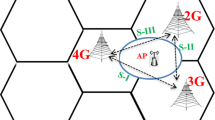Abstract
In this paper, we evaluate the performance of two WMN architectures (infrastructure/backbone WMNs (I/B WMNs) and Hybrid WMN architectures) considering throughput, delay, jitter and fairness index metrics. For simulations, we used ns-3 and optimized link state routing. We compare the performance of distributed coordination function and enhanced distributed channel access (EDCA) for exponential and Weibull distributions of mesh clients by sending multiple constant bit rate flows in the network. The simulation results show that for exponential distribution, in case of Hybrid WMN, the throughput of both MAC protocols is higher than I/B WMN. For 30 flows, the throughput of EDCA in case of hybrid WMN is about 1.4 times higher than I/B WMN. For Weibull distribution, in case of I/B WMN, the throughput of both MAC protocols is higher than Hybrid WMN. For 30 flows, the throughput of EDCA in case of I/B WMN is about 2.6 times higher than Hybrid WMN. For exponential distribution, the delay and jitter of Hybrid WMN are lower than I/B WMN. For 20 flows, the delay of EDCA in case of hybrid WMN is about 10 times lower than I/B WMN. For Weibull distribution, the delay and jitter of both architectures are almost the same. However, for 10 flows, the delay of I/B WMN is lower compared with hybrid WMN. For exponential distribution, the fairness index of I/B WMN is a little bit higher than hybrid WMN. For Weibull distribution, the fairness index is almost the same for both WMN architectures.













Similar content being viewed by others
References
Akyildiz IF, Wang X, Wang W (2005) Wireless mesh networks: a survey. Comput Netw 47(4):445–487
Clausen T and Jacquet P (2003) Optimized link state routing protocol (OLSR). RFC 3626 (Experimental)
Franklin A, Murthy C (2007) Node placement algorithm for deployment of two-tier wireless mesh networks. In: IEEE GLOBECOM-2007, pp 4823–4827
IEEE 802.11 (2007) Wireless LAN medium access control (MAC) and physical layer (PHY) specifications. IEEE Computer Society Std. http://standards.ieee.org/getieee802/download/802.11-2007.pdf
IEEE-SA (1999) IEEE 802.11 part 11: wireless LAN medium access control (MAC) and physical layer (PHY) specifications. http://standards.ieee.org/about/get/802/802.11.html
IEEE-SA (2005) IEEE 802.11e amendment: medium access control (MAC) quality of service (QoS) enhancements. https://standards.ieee.org/findstds/standard/802.11e-2005.html
Ikeda M, Oda T, Kulla E, Hiyama M, Barolli L and Younas M (2012) Performance evaluation of WMN considering number of connections using ns-3 simulator. In: The 7-th international conference on broadband and wireless computing, communication and applications (BWCCA-2012), pp 492–502
Lim A, Rodrigues B, Wang F, Xua Zh (2005) \(k-\)center problems with minimum coverage. Theoret Comput Sci 332(1–3):1–17
Mukherjee S, Xiao-Hong P, Gao Q (2009) QoS performances of IEEE 802.11 EDCA and DCF: a testbed approach, The 5-th international conference wireless communications, networking and mobile computing (WiCom-09), pp 1–5
Muthaiah SN and Rosenberg C (2008) Single gateway placement in wireless mesh networks. The 8-th International IEEE Symposium on Computer Networks, pp 4754–4759
Oda T, Barolli A, Spaho E, Xhafa F, Barolli L, Takizawa M (2012) Evaluation of WMN-GA for different mutation operators. Int J Space-Based Situat Comput (IJSSC) 2(3):149–157
Oda T, Barolli A, Xhafa F, Barolli L, Ikeda M, Takizawa M (2013) WMN-GA: a simulation system for WMNs and its evaluation considering selection operators. J Ambient Intell Humaniz Comput (JAIHC) 4(3):323–330
Oda T, Barolli A, Spaho E, Barolli L, Xhafa F (2014) Analysis of mesh router placement in wireless mesh networks using friedman test. The 28-th IEEE international conference on advanced information networking and applications (IEEE AINA-2014), pp 289–296
Oda T, Sakamoto S, Barolli A, Ikeda M, Barolli L, Xhafa F (2014) A GA-based simulation system for WMNs: performance analysis for different WMN architectures considering TCP. The 8-th international conference on broadband and wireless computing, communication and applications (BWCCA-2014):120-126
Oda T, Elmazi D, Barolli A, Sakamoto S, Barolli L, Xhafa F (2015) A genetic algorithm based system for wireless mesh networks: analysis of system data considering different routing protocols and architectures. J Soft Comput (SOCO). doi:10.1007/s00500-015-1663-z:1-14
Tang M (2009) Gateways placement in backbone wireless mesh networks. Int J Commun Netw Syst Sci 2(1):45–50
Xhafa F, Sanchez C, and Barolli L (2009) Locals search algorithms for efficient router nodes placement in wireless mesh networks. In: International conference on network-based information systems (NBiS-2009), pp 572–579
Vanhatupa T, Hännikäinen M and Hämäläinen TD (2007) Genetic algorithm to optimize node placement and configuration for WLAN planning. The 4-th international symposium on wireless communication systems, pp 612–616
Wang J, Xie B, Cai K and Agrawal DP (2007) Efficient mesh router placement in wireless mesh networks. In: MASS, pp 9–11
“ns-3”. https://www.nsnam.org/. Accessed 15 Sept 2016
The Network Simulator-ns-2. http://www.isi.edu/nsnam/ns/. Accessed 15 Sept 2016
Author information
Authors and Affiliations
Corresponding author
Ethics declarations
Funding
This study was not funded by any grant.
Conflict of interest
All authors declares that they have no conflict of interest.
Ethical approval
This article does not contain any studies with human participants performed by any of the authors.
Rights and permissions
About this article
Cite this article
Shinko, I., Kolici, V., Obukata, R. et al. Performance analysis of a genetic algorithm based system for wireless mesh networks considering exponential and weibull distributions, DCF and EDCA, and different number of flows. J Ambient Intell Human Comput 9, 699–707 (2018). https://doi.org/10.1007/s12652-017-0468-6
Received:
Accepted:
Published:
Issue Date:
DOI: https://doi.org/10.1007/s12652-017-0468-6




